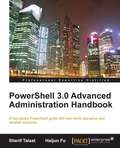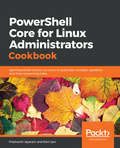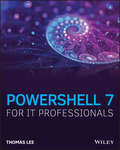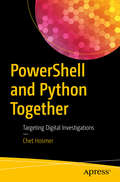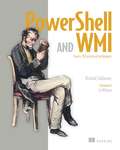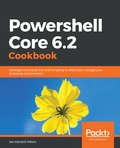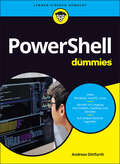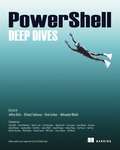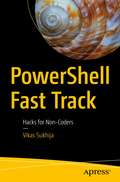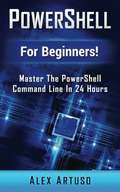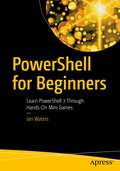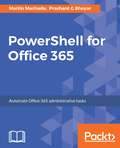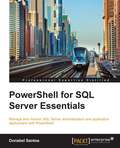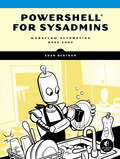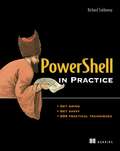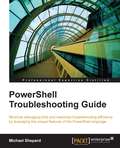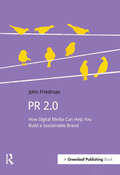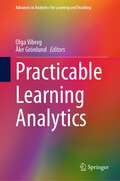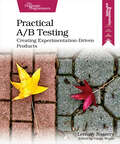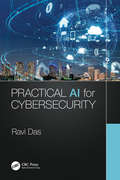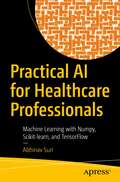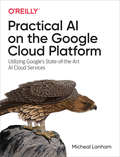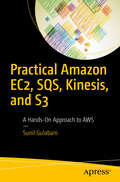- Table View
- List View
PowerShell 3.0 Advanced Administration Handbook
by Sherif Talaat Haijun FuThis book is a collection of selected real-world scenarios, detailed solutions, and screenshots.If you are a system administrator who wants to automate repeated daily tasks and perform complex administration requirements in a timely manner with less effort, then this is the book for you.In order to get the maximum benefit of this book you need to have some basic scripting knowledge and good administration experience.
PowerShell 6.0 Linux Administration Cookbook: Use PowerShell Core 6.x on Linux to automate complex, repetitive, and time-consuming tasks
by Prashanth Jayaram Ram IyerIf you are system administrator who wants to learn to control and automate your Linux environment with PowerShell 6.0 then, this book is for you. Basic knowledge of PowerShell scripting would be necessary. Very basic knowledge required with respect to how an operating system is structured and how to use the command line interface to work with the operating system.
PowerShell 7 for IT Professionals: A Guide To Using Powershell 7 To Manage Windows Systems
by Thomas LeeTake advantage of everything Microsoft’s new PowerShell 7 has to offer PowerShell 7 for IT Pros is your guide to using PowerShell 7, the open source, cross-platform version of Windows PowerShell. Windows IT professionals can begin setting up automation in PowerShell 7, which features many improvements over the early version of PowerShell Core and Windows PowerShell. PowerShell 7 users can enjoy the high level of compatibility with the Windows PowerShell modules they rely on today. This book shows IT professionals—especially Windows administrators and developers—how to use PowerShell7 to engage in their most important tasks, such as managing networking, using AD/DNS/DHCP, leveraging Azure, and more. To make it easy to learn everything PowerShell 7 has to offer, this book includes robust examples, each containing sample code so readers can follow along. Scripts are based on PowerShell 7 running on Windows 10 19H1 or later and Windows Server 2019. • Learn to navigate the PowerShell 7 administrative environment • Use PowerShell 7 to automate networking, Active Directory, Windows storage, shared data, and more • Run Windows Update, IIS, Hyper-V, and WMI and CIM cmdlets within PowerShell 7 • Understand how to handle reporting in the new PowerShell 7 environment PowerShell 7 for IT Pros provides exclusive coverage of using PowerShell with both cloud-based systems and virtualized environments (Hyper V and Azure). Written by PowerShell veteran Thomas Lee, this is the only book you’ll need to get started with PowerShell 7.
PowerShell and Python Together: Targeting Digital Investigations
by Chet HosmerBring together the Python programming language and Microsoft’s PowerShell to address digital investigations and create state-of-the-art solutions for administrators, IT personnel, cyber response teams, and forensic investigators.You will learn how to join PowerShell's robust set of commands and access to the internals of both the MS Windows desktop and enterprise devices and Python's rich scripting environment allowing for the rapid development of new tools for investigation, automation, and deep analysis.PowerShell and Python Together takes a practical approach that provides an entry point and level playing field for a wide range of individuals, small companies, researchers, academics, students, and hobbyists to participate. What You’ll Learn Leverage the internals of PowerShell for: digital investigation, incident response, and forensicsLeverage Python to exploit already existing PowerShell CmdLets and aliases to build new automation and analysis capabilitiesCreate combined PowerShell and Python applications that provide: rapid response capabilities to cybersecurity events, assistance in the precipitous collection of critical evidence (from the desktop and enterprise), and the ability to analyze, reason about, and respond to events and evidence collected across the enterprise Who This Book Is For System administrators, IT personnel, incident response teams, forensic investigators, professors teaching in undergraduate and graduate programs in cybersecurity, students in cybersecurity and computer science programs, and software developers and engineers developing new cybersecurity defenses
PowerShell and WMI
by Richard SiddawaySummary PowerShell and WMI is an example-driven guide for administrators managing networks of Windows servers and desktops. With 150 practical examples, including ready-to-reuse scripts and techniques, you'll learn the ins and outs of automating WMI via PowerShell v3. You'll also find deep coverage of all aspects of Windows administration, including IIS, DNS and Hyper-V. About the Technology WMI, on its own, is simply a collection of Windows management facilities. Paired with PowerShell, however, WMI becomes a brilliant toolset for automating servers, networks, and remote Windows computers. About the Book PowerShell and WMI is an industrial-strength guide for administrators of Windows networks, servers, and desktops. You'll start with practical overviews of PowerShell and of WMI. Then you'll explore 150 specific examples—all with ready-to-use scripts—designed to simplify your day-to-day system management. Each tested technique is configured to load as part of a PowerShell module. A set of handy appendixes includes references for PowerShell and WMI. Prior exposure to PowerShell and WMI is helpful but not required. Purchase of the print book comes with an offer of a free PDF, ePub, and Kindle eBook from Manning. Also available is all code from the book. What's Inside Managing Windows, IIS, and Hyper-V Remote desktops and devices Logs, jobs, and performance New PowerShell v3 WMI functionality =============================== Table of Contents PART 1 TOOLS OF THE TRADE Solving administrative challenges Using PowerShell WMI in depth Best practices and optimization PART 2 WMI IN THE ENTERPRISE? System documentation Disk systems Registry administration Filesystem administration Services and processes Printers Configuring network adapters Managing IIS Configuring a server Users and security Logs, jobs, and performance Administering Hyper-V with PowerShell and WMI PART 3 THE FUTURE: POWERSHELL V3 AND WMI WMI over WSMAN Your own WMI cmdlets CIM cmdlets and sessions
Powershell Core 6.1 Cookbook: Leverage command-line shell scripting to effectively manage your enterprise environment
by Jan-Hendrik PetersThis book will be for windows administrators who want to enhance their PowerShell scripting skills to the next level. System administrators wanting to automate common to complex tasks with PowerShell scripts would benefit from this book. Prior understanding on PowerShell would be necessary.
PowerShell Core für Dummies (Für Dummies)
by Andreas DittfurthWas kann die neue PowerShell auf den verschiedenen Betriebssystemen? Was kann sie nicht? Dieses Buch bietet eine praxisorientierte Einführung in die PowerShell-Welt mit vielen Beispielen. Lernen Sie wichtige Cmdlets, die Arbeit mit Objekten und den Gebrauch von Funktionen, Skripten und Modulen kennen. Für Umsteiger sind besonders die Unterschiede zur Windows PowerShell interessant. Grundlegende Kenntnisse im Umgang mit Windows, Linux oder macOS sind zum Verständnis des Buchs völlig ausreichend.
PowerShell Deep Dives
by Oisin Grehan Aleksandar Nikolic Jeffery Hicks Richard SiddawaySummaryHere's your chance to learn from the best in the business. PowerShell Deep Dives is a trove of essential techniques, practical guidance, and the expert insights you earn only through years of experience. Editors Jeffery Hicks, Richard Siddaway, Oisin Grehan, and Aleksandar Nikolic hand-picked the 28 chapters in the book's four parts: Administration, Scripting, Development, and Platforms.About the TechnologyPowerShell has permanently changed Windows administration. This powerful scripting and automation tool allows you to control virtually every aspect of Windows and most Microsoft servers like IIS and SQL Server. Here's your chance to learn from the best in the business.About this BookPowerShell Deep Dives is a trove of essential techniques and practical guidance. It is rich with insights from experts who won them through years of experience. The book's 28 chapters, grouped in four parts (Administration, Scripting, Development, and Platforms), were hand-picked by four section editors: Jeffery Hicks, Richard Siddaway, Oisin Grehan, and Aleksandar Nikolic.Whether you're just getting started with PowerShell or you already use it daily, you'll find yourself returning to this book over and over.What's InsideManaging systems through a keyholeThe Ten Commandments of PowerShell scriptingScalable scripting for large datasetsAdding automatic remotingProvisioning web servers and websites automatically to IIS 8And 23 more fantastic chaptersPurchase of the print book includes a free eBook in PDF, Kindle, and ePub formats from Manning Publications.About the AuthorsEditors Jeffery Hicks, Richard Siddaway, Oisin Grehan, and Aleksandar Nikolic are joined by PowerShell experts Chris Bellee, Bartek Bielawski, Robert C. Cain, Jim Christopher, Adam Driscoll, Josh Gavant, Jason Helmick, Don Jones, Ashley McGlone, Jonathan Medd, Ben Miller, James O'Neill, Arnaud Petitjean, Vadims Podans, Karl Prosser, Boe Prox, Matthew Reynolds, Mike Robbins, Donabel Santos, Will Steele, Trevor Sullivan, and Jeff Wouters.Table of ContentsPART 1 POWERSHELL ADMINISTRATIONDiagnosing and troubleshooting PowerShell remotingCIM sessions 22Collecting and analyzing performance counter dataTCP port communications with PowerShellManaging systems through a keyholeUsing PowerShell to audit user logon eventsManaging and administering a certification authoritydatabase with PowerShellUsing PowerShell to reduce Active Directory token bloatPART 2 POWERSHELL SCRIPTINGThe 10 PowerShell scripting commandmentsAvoiding the pipelineA template for handling and reporting errorsTips and tricks for creating complex or advancedHTML reports with PowerShellUsing and "abusing" dynamic parametersPowerShell type formattingScalable scripting for large data sets: pipelineand database techniquesBuilding your own WMI-based cmdletsTurning command-line tools into PowerShell toolsPART 3 POWERSHELL FOR DEVELOPERSUsing Source Control Software with PowerShellInline .NET codePowerShell and XML: better togetherAdding automatic remoting to advanced functionsand cmdletsTaming software builds (and other complicated processes)with psakePART 4 POWERSHELL PLATFORMSPowerShell and the SQL Server providerCreating flexible subscriptions in SSRSInventory database table statistics using PowerShellSQL Server Management ObjectsWSUS and PowerShellProvisioning IIS web servers and sites with PowerShellActive Directory Group Management application
PowerShell Fast Track: Hacks for Non-Coders
by Vikas SukhijaCreate complex scripts in PowerShell and learn how to connect them to cloud services like Azure and Azure AD. This book will help you learn PowerShell by providing small “cheat” snippets that you can combine to write efficient and effective scripts. PowerShell Fast Track starts with the basics of PowerShell before moving on to discuss functions like date and logs, along with concepts such as inputs for your scripts. Author Vikas Sukhija then walks you through interactive input and Snapins modules, where you will learn GUI button prompts and how to import sessions. He’ll then show you how to report errors through email and log errors to a text file. Reporting CSV (Comma Separate Value) is discussed next, followed by a demonstration of miscellaneous functions, including how to connect your PowerShell scripts with Azure, SharePoint, Teams and other services. As you progress further, you’ll see how PowerShell provides powerful features for automation that can be leveraged for managing your Teams workload. Finally, using practical examples, you will learn how to implement and create scripts for day-to-day usage. After reading this book, you will be able to hit the ground running and use PowerShell’s powerful features in your own work. What Will You Learn: Utilize code Snippets to perform practical tasksCombine the code to create more complex scripts.Logging and reportingConnect to various products such as Exchange, SharePoint, Teams, and AzureAD Who Is This Book For: System administrators
PowerShell For Beginners!: Master The PowerShell Command Line In 24 Hours
by Alex ArtusoPowerShell is a fantastic first or second programming language to learn (and master with the help of this book!). There's a ton of other technical guides out there that aren't clear and concise, and in my opinion use far too much jargon. My job is to teach you in simple, easy to follow terms how to get started and excel at PowerShell programming. You'll find my personal notes and tips peppered throughout the book, making it personal and easy to learn.
PowerShell for Beginners: Learn PowerShell 7 Through Hands-On Mini Games
by Ian WatersLearn the basic tools and commands to write scripts in PowerShell 7. This hands-on guide is designed to get you up and running on PowerShell quickly - introducing interactive menus, reading and writing files, and creating code that talks over the network to other scripts, with mini games to facilitate learning. PowerShell for Beginners starts with an introduction to PowerShell and its components. It further discusses the various tools and commands required for writing scripts in PowerShell 7, with learning reinforced by writing mini games. You will learn how to use variables and conditional statements for writing scripts followed by loops and arrays. You will then work with functions and classes in PowerShell. Moving forward, you will go through the PowerShell Console, customizing the title and text colors. Along the way you will see how to read a key press and make sound in PowerShell. The final sections cover game engine layout, how to build a title screen, and implementing the game design using code flow, title screens, levels, and much more. After reading the book you will be able to begin working with PowerShell 7 scripts and understand how to use its tools and commands effectively.What You Will LearnUse Microsoft Visual Studio Code to develop scriptsUnderstand variables, loops and conditional statements in PowerShellWork with scripts to develop a gameDiscover and use ASCII art generatorsComprehend game objects and codeCreate client-server scripts that communicate over a networkRead and write to filesCapture input from the keyboardMake PowerShell speak words to help the visually impairedCreate text-based adventure games Who This Book Is ForSoftware developers who want to start working with PowerShell scripts.
PowerShell for Office 365
by Martin Machado Prashant G BhoyarLearn the art of leveraging PowerShell to automate Office 365 repetitive tasks About This Book • Master the fundamentals of PowerShell to automate Office 365 tasks. • Easily administer scenarios such as user management, reporting, cloud services, and many more. • A fast-paced guide that leverages PowerShell commands to increase your productivity. Who This Book Is For The book is aimed at sys admins who are administering office 365 tasks and looking forward to automate the manual tasks. They have no knowledge about PowerShell however basic understanding of PowerShell would be advantageous. What You Will Learn • Understand the benefits of scripting and automation and get started using Powershell with Office 365 • Explore various PowerShell packages and permissions required to manage Office 365 through PowerShell • Create, manage, and remove Office 365 accounts and licenses using PowerShell and the Azure AD • Learn about using powershell on other platforms and how to use Office 365 APIs through remoting • Work with Exchange Online and SharePoint Online using PowerShell • Automate your tasks and build easy-to-read reports using PowerShell In Detail While most common administrative tasks are available via the Office 365 admin center, many IT professionals are unaware of the real power that is available to them below the surface. This book aims to educate readers on how learning PowerShell for Office 365 can simplify repetitive and complex administrative tasks, and enable greater control than is available on the surface. The book starts by teaching readers how to access Office 365 through PowerShell and then explains the PowerShell fundamentals required for automating Office 365 tasks. You will then walk through common administrative cmdlets to manage accounts, licensing, and other scenarios such as automating the importing of multiple users,assigning licenses in Office 365, distribution groups, passwords, and so on. Using practical examples, you will learn to enhance your current functionality by working with Exchange Online, and SharePoint Online using PowerShell. Finally, the book will help you effectively manage complex and repetitive tasks (such as license and account management) and build productive reports. By the end of the book, you will have automated major repetitive tasks in Office 365 using PowerShell. Style and approach This step by step guide focuses on teaching the fundamentals of working with PowerShell for Office 365. It covers practical usage examples such as managing user accounts, licensing, and administering common Office 365 services. You will be able to leverage the processes laid out in the book so that you can move forward and explore other less common administrative tasks or functions.
PowerShell for SQL Server Essentials
by Donabel SantosThis book is written for SQL Server administrators and developers who want to leverage PowerShell to work with SQL Server. Some background with scripting will be helpful but not necessary.
PowerShell for Sysadmins: Workflow Automation Made Easy
by Adam BertramLearn to use PowerShell, Microsoft's scripting language, to automate real-world tasks that IT professionals and system administrators deal with every day.Save Time. Automate.PowerShell® is both a scripting language and an administrative shell that lets you control and automate nearly every aspect of IT. In PowerShell for Sysadmins, five-time Microsoft® MVP "Adam the Automator" Bertram shows you how to use PowerShell to manage and automate your desktop and server environments so that you can head out for an early lunch.You'll learn how to: • Combine commands, control flow, handle errors, write scripts, run scripts remotely, and test scripts with the PowerShell testing framework, Pester • Parse structured data like XML and JSON, work with common domains (like Active Directory, Azure, and Amazon Web Services), and create a real-world server inventory script • Design and build a PowerShell module to demonstrate PowerShell isn't just about ad-hoc scripts • Use PowerShell to create a hands-off, completely automated Windows deployment • Build an entire Active Directory forest from nothing but a Hyper-V host and a few ISO files • Create endless Web and SQL servers with just a few lines of code!Real-world examples throughout help bridge the gap between theory and actual system, and the author's anecdotes keep things lively.Stop with the expensive software and fancy consultants. Learn how to manage your own environment with PowerShell for Sysadmins and make everyone happy.Covers Windows PowerShell v5.1
PowerShell in Depth
by Don Jones Jeffery Hicks Richard SiddawaySummaryPowerShell in Depth, Second Edition is the go-to reference for administrators working with Windows PowerShell. Every major technique, technology, and tactic is carefully explained and demonstrated, providing a hands-on guide to almost everything an admin would do in the shell. Written by three experienced authors and PowerShell MVPs, this is the PowerShell book you'll keep next to your monitor—not on your bookshelf! Purchase of the print book includes a free eBook in PDF, Kindle, and ePub formats from Manning Publications.About the BookA Windows admin using PowerShell every day may not have the time to search the net every time he or she hits a snag. Wouldn't it be great to have a team of seasoned PowerShell experts ready to answer even the toughest questions? That's what you get with this book. PowerShell in Depth, Second Edition is the go-to reference for administrators working with Windows PowerShell. Every major technique, technology, and tactic is carefully explained and demonstrated, providing a hands-on guide to almost everything an admin would do in the shell. Written by PowerShell MVPs Don Jones, Jeffrey Hicks, and Richard Siddaway, each valuable technique was developed and thoroughly tested, so you'll be able to consistently write production-quality, maintainable scripts while saving hours of time and effort. This book assumes you know the basics of PowerShell. What's InsideAutomating tasksPackaging and deploying scriptsIntroduction to Desired State ConfigurationPowerShell securityCovers PowerShell version 3 and laterAbout the AuthorsDon Jones, Jeffery Hicks, and Richard Siddaway are Microsoft MVPs, trainers, and administrators. Collectively, they've authored nearly three dozen books on PowerShell and Windows administration.Table of ContentsPART 1 POWERSHELL FUNDAMENTALSIntroductionPowerShell hostsUsing the PowerShell help systemThe basics of PowerShell syntaxWorking with PSSnapins and modulesOperatorsWorking with objectsThe PowerShell pipelineFormattingPART 2 POWERSHELL MANAGEMENTPowerShell RemotingBackground jobs and schedulingWorking with credentialsRegular expressionsWorking with HTML and XML dataPSDrives and PSProvidersVariables, arrays, hash tables, and script blocksPowerShell securityAdvanced PowerShell syntaxPART 3 POWERSHELL SCRIPTING AND AUTOMATIONPowerShell's scripting languageBasic scripts and functionsCreating objects for outputScopePowerShell workflowsAdvanced syntax for scripts and functionsScript modules and manifest modulesCustom formatting viewsCustom type extensionsData language and internationalizationWriting helpError handling techniquesDebugging tools and techniquesFunctions that work like cmdletsTips and tricks for creating reportsPART 4 ADVANCED POWERSHELLWorking with the Component Object Model (COM) Working with .NET Framework objectsAccessing databasesProxy functionsBuilding a GUIWMI and CIMWorking with the webDesired State Configuration
PowerShell in Practice
by Richard SiddawayWindows PowerShell is a scripting language that simplifies Windows system administration. PowerShell in Practice is a hands-on reference for administrators wanting to learn and use PowerShell. Following the "in Practice" style, individual related techniques are clustered into chapters. Each technique is presented in the form: problem, solution, discussion, and includes annotated code listings.Written to answer the question "How can PowerShell make my job as an administrator easier?" this book concentrates on practical tasks and automation. Starting with an a brief tutorial and review, the majority of the book focuses on two major PowerShell usage areas: People - user accounts, mailboxes, desktop configuration; and Servers - Active Directory, Exchange, IIS, and more. Purchase of the print book comes with an offer of a free PDF, ePub, and Kindle eBook from Manning. Also available is all code from the book.
PowerShell Troubleshooting Guide
by Michael ShepardWindows PowerShell provides an amazing platform for administrative scripting and automation. Understanding the PowerShell language will enable you to spend less time troubleshooting and be more effective when debugging is required. PowerShell also includes several avenues to provide feedback from your code that will make your troubleshooting and debugging time more profitable.</p><p>Improved coding practices combined with useful diagnostic information can lead to results quickly. This book starts with background information on the purposes of automation and PowerShell's entrance into Microsoft's automation strategy, and also answers the question of whether scripting (and specifically PowerShell scripting) is essentially different than traditional programming. A brief overview of the main features of the PowerShell language along with examples is provided. Focus is placed on proper script design and use of PowerShell features in an attempt to reduce the need for troubleshooting.
PR 2.0: How Digital Media Can Help You Build a Sustainable Brand (Doshorts Ser.)
by John FriedmanDigital media offer many of the same characteristics – immediacy, transparency and interactivity – that make one-to-one the most effective form of communication. And yet many organizations do not fully embrace them. They simultaneously underestimate and fear the power of digital communications. And yet these tools, when used strategically, can be an effective part of your communications plan.PR 2.0 will help you: 1. understand how the increasing emphasis on transparency driven by corporate responsibility has changed the ways that effective organizations communicate with their stakeholders; 2. develop a communications plan for your organization that reaches, and engages, the right stakeholders, using the most appropriate tools and channels; 3. demonstrate the value and “sell” the use of digital media to skeptical internal stakeholders, including in the c-suite, as part of your mission-advancing communications plan. You can make the most of the irrevocable changes in the way people create, share, receive, judge and interact with information. This book offers real-world examples and practical tools to help your organization to live its values and effectively engage with those most essential to your success.
PR im Social Web (O'Reillys Basics)
by Marie-Christine Schindler Tapio LillerInteressante Zeiten für Kommunikationsprofis: Mit dem Erstarken des Social Web verändert sich das Verhältnis zwischen Unternehmen bzw. Agenturen und ihren Dialoggruppen - Transparenz und Austausch werden immer wichtiger. PR im Social Web zeigt, was das für die PR-Arbeit bedeutet. Die Autoren, selbst erfahrene PR-Profis, erläutern die veränderten Rahmenbedingungen und erklären, wie die einzelnen PR-Disziplinen und Unternehmensbereiche von Social Media profitieren können. Zahlreiche Fallstudien, Tipps und Checklisten erleichtern es Ihnen, das Gelesene auf Ihre eigenen Kommunikationsziele anzuwenden. Für die zweite Auflage wurde das Buch komplett aktualisiert und um Kapitel zu Nonprofit-PR und Erfolgsmessung ergänzt. Von der Medienarbeit bis zur Krisenkommunikation Die Medienarbeit wird durch Aktivitäten im Social Web bereichert - Blogger Relations, Monitoring, Issues Management und der Umgang mit Kritik und Krisen sind nur einige wichtige Stichworte. Corporate Publishing und Events Corporate Blogs und Podcasts bieten interessante Publikations- und Dialogmöglichkeiten, und Events erhalten über soziale Netzwerke und Livestreams eine deutlich größere Öffentlichkeit. Personalmarketing und Interne Kommunikation Vom Employer Branding über Recruiting bis zum Einsatz von Social Media im Unternehmen selbst - für die HR-Kommunikation bietet sich das Social Web mit seinen Dialogmöglichkeiten geradezu an. Kundenservice und Support Keine klassischen PR-Disziplinen, doch auch Kundenservice und Support werden durch die Social Media erheblich persönlicher und können so viel Positives zur öffentlichen Wahrnehmung eines Unternehmens beitragen. Wie sich der PR-Beruf ändert Vieles ist im Umbruch, davon sind auch die Aufgabenverteilung zwischen Unternehmen und Agenturen sowie das Berufsbild des PR-Profis selbst betroffen. NEU: Messbarkeit im Social Web: von KPI bis ROI Zahlt sich Social Media-PR überhaupt aus? Auch wenn es bei der Kommunikation im Social Web nicht vorrangig um harte Zahlen geht - strategisch geplant und durchgeführt, lassen sich ihre Erfolge durchaus überprüfen. Der Rechtsrahmen In einem Gastkapitel erläutert Rechtsanwalt Henning Krieg, was bei der Kommunikation im Social Web zu beachten ist - ob bei der Verbreitung von Content oder der Definition von Social Media Guidelines.
Practicable Learning Analytics (Advances in Analytics for Learning and Teaching)
by Olga Viberg Åke GrönlundThis book is about practicable learning analytics, that is able to become a successful part of practice, ultimately leading to improved learning and teaching. The aim of the book is to shift our perspective on learning analytics creation and implementation from that of “designing of” technology to that of “designing for” a system of practice. That is, any successful implementation of learning analytics requires a systematic approach, which the book explains through the lens of the Information Systems Artefact, constituting of the three interdependent artefacts: “technical”, “information” and “social”.The contributions of this book go beyond a consideration of particular humans such as teachers and students, and their individual activities to consider the larger systems of activity of which analytics become part of. The chapters included in this book present different cases of learning analytics implementation across countries, and the related opportunities and challenges related to generalizability of the results.The book is written for designers, students and educators of learning analytics who aim to improve learning and teaching through learning analytics.
Practical A/B Testing: Creating Experimentation-driven Products
by Leemay NasseryWhether you're a catalyst for organizational change or have the support you need to create an engineering culture that embraces A/B testing, this book will help you do it right. The step-by-step instructions will demystify the entire process, from constructing an A/B test to breaking down the decision factors to build an engineering platform. When you're ready to run the A/B test of your dreams, you'll have the perfect blueprint.With smart, tactful approaches to orchestrating A/B testing on a product, you'll quickly discover how to reap all the benefits that A/B testing has to offer - benefits that span your users, your product, and your team. Take the reins today, and be the change you want to see in your engineering and product organizations.Develop a hypothesis statement that's backed with metrics that demonstrate if your prediction for the experiment is correct. Build more inclusive products by leveraging audience segmentation strategies and ad-hoc post analysis to better understand the impact of changes on specific user groups. Determine which path is best for your team when deciding whether to go with a third-party A/B test framework or to build the A/B testing platform in-house. And finally, learn how to cultivate an experimentation-friendly culture within your team.Leverage the A/B testing methodology to demonstrate the impact of changes on a product to your users, your key business metrics, and the way your team works together. After all, if you aren't measuring the impact of the changes you make, how will you know if you're truly making improvements?
Practical AI for Cybersecurity
by Ravi DasThe world of cybersecurity and the landscape that it possesses is changing on a dynamic basis. It seems like that hardly one threat vector is launched, new variants of it are already on the way. IT Security teams in businesses and corporations are struggling daily in order to fight off any cyberthreats that they are experiencing. On top of this, they are also asked by their CIO or CISO to try to model what future Cyberattacks could potentially look like, and ways as to how the lines of defenses can be further enhanced. IT Security teams are overburdened and are struggling to find ways in order to keep up with what they are being asked to do. Trying to model the cyberthreat landscape is a very time consuming and laborious process, because it takes a lot of time to analyze datasets from many intelligence feeds. What can be done to accomplish this Herculean task? The answer lies in Artificial Intelligence (AI). With AI, an IT Security team can model what the future Cyberthreat landscape could potentially look like in just a matter of minutes. As a result, this gives valuable time for them not only to fight off the threats that they are facing, but to also come up with solutions for the variants that will come out later. Practical AI for Cybersecurity explores the ways and methods as to how AI can be used in cybersecurity, with an emphasis upon its subcomponents of machine learning, computer vision, and neural networks. The book shows how AI can be used to help automate the routine and ordinary tasks that are encountered by both penetration testing and threat hunting teams. The result is that security professionals can spend more time finding and discovering unknown vulnerabilities and weaknesses that their systems are facing, as well as be able to come up with solid recommendations as to how the systems can be patched up quickly.
Practical AI for Healthcare Professionals: Machine Learning with Numpy, Scikit-learn, and TensorFlow
by Abhinav SuriPractical AI for Healthcare Professionals Artificial Intelligence (AI) is a buzzword in the healthcare sphere today. However, notions of what AI actually is and how it works are often not discussed. Furthermore, information on AI implementation is often tailored towards seasoned programmers rather than the healthcare professional/beginner coder. This book gives an introduction to practical AI in the medical sphere, focusing on real-life clinical problems, how to solve them with actual code, and how to evaluate the efficacy of those solutions. You’ll start by learning how to diagnose problems as ones that can and cannot be solved with AI. You’ll then learn the basics of computer science algorithms, neural networks, and when each should be applied. Then you’ll tackle the essential parts of basic Python programming relevant to data processing and making AI programs. The Tensorflow/Keras library along with Numpy and Scikit-Learn are covered as well. Once you’ve mastered those basic computer science and programming concepts, you can dive into projects with code, implementation details, and explanations. These projects give you the chance to explore using machine learning algorithms for issues such as predicting the probability of hospital admission from emergency room triage and patient demographic data. We will then use deep learning to determine whether patients have pneumonia using chest X-Ray images. The topics covered in this book not only encompass areas of the medical field where AI is already playing a major role, but also are engineered to cover as much as possible of AI that is relevant to medical diagnostics. Along the way, readers can expect to learn data processing, how to conceptualize problems that can be solved by AI, and how to program solutions to those problems. Physicians and other healthcare professionals who can master these skills will be able to lead AI-based research and diagnostic tool development, ultimately benefiting countless patients.
Practical AI on the Google Cloud Platform: Utilizing Google's State-of-the-art Ai Cloud Services
by Micheal LanhamWorking with AI is complicated and expensive for many developers. That's why cloud providers have stepped in to make it easier, offering free (or affordable) state-of-the-art models and training tools to get you started. With this book, you'll learn how to use Google's AI-powered cloud services to do everything from creating a chatbot to analyzing text, images, and video.Author Micheal Lanham demonstrates methods for building and training models step-by-step and shows you how to expand your models to accomplish increasingly complex tasks. If you have a good grasp of math and the Python language, you'll quickly get up to speed with Google Cloud Platform, whether you want to build an AI assistant or a simple business AI application.Learn key concepts for data science, machine learning, and deep learningExplore tools like Video AI and AutoML TablesBuild a simple language processor using deep learning systemsPerform image recognition using CNNs, transfer learning, and GANsUse Google's Dialogflow to create chatbots and conversational AIAnalyze video with automatic video indexing, face detection, and TensorFlow HubBuild a complete working AI agent application
Practical Amazon EC2, SQS, Kinesis, and S3
by Sunil GulabaniProvide solutions to all your Amazon EC2, SQS, Kinesis, and S3 problems, including implementation using the AWS Management Console, AWS CLI, and AWS SDK (Java). You'll find recipes on implementation and configuration of Amazon EC2, SQS, Kinesis, and S3 along with the code snippets and AWS CLI commands. Practical Amazon EC2, SQS, Kinesis, and S3 uses focused examples that include only the details you need to get things done. You'll see production use cases of Amazon EC2, SQS, Kinesis, and S3 and how to implement cloud watch in projects for these services. Learn how to raise an alarm on Amazon EC2, SQS, Kinesis, and S3 as part of a continuous monitoring system designed to increase performance and avoid side effects in your services. What You'll Learn Manage Amazon EC2, SQS, Kinesis, and S3 using the AWS Management Console Use the AWS CLI Employ the AWS Java SDK Configure alarms on Amazon EC2, SQS, Kinesis, and S3 Who This Book Is For Software developers and architects, system engineers, and project managers
